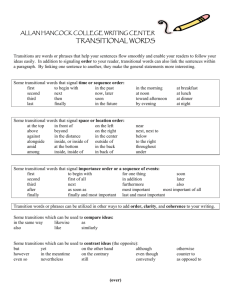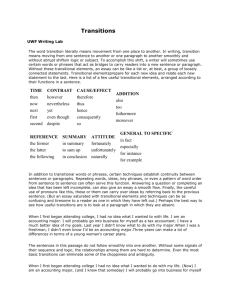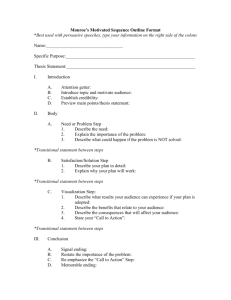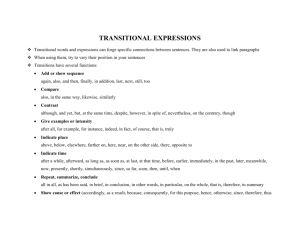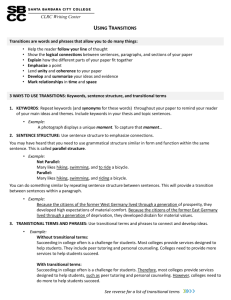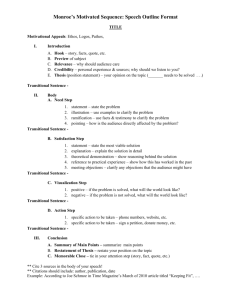Lost in Transition: Challenges and Opportunities for Improving the
advertisement
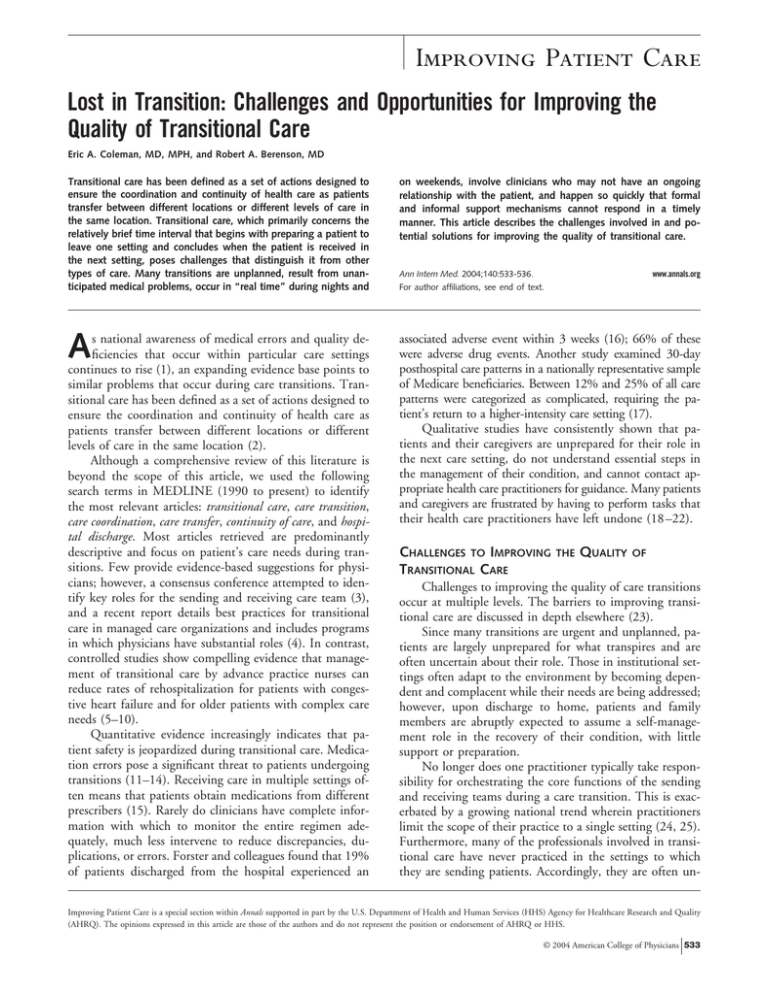
Improving Patient Care Lost in Transition: Challenges and Opportunities for Improving the Quality of Transitional Care Eric A. Coleman, MD, MPH, and Robert A. Berenson, MD Transitional care has been defined as a set of actions designed to ensure the coordination and continuity of health care as patients transfer between different locations or different levels of care in the same location. Transitional care, which primarily concerns the relatively brief time interval that begins with preparing a patient to leave one setting and concludes when the patient is received in the next setting, poses challenges that distinguish it from other types of care. Many transitions are unplanned, result from unanticipated medical problems, occur in “real time” during nights and on weekends, involve clinicians who may not have an ongoing relationship with the patient, and happen so quickly that formal and informal support mechanisms cannot respond in a timely manner. This article describes the challenges involved in and potential solutions for improving the quality of transitional care. A associated adverse event within 3 weeks (16); 66% of these were adverse drug events. Another study examined 30-day posthospital care patterns in a nationally representative sample of Medicare beneficiaries. Between 12% and 25% of all care patterns were categorized as complicated, requiring the patient’s return to a higher-intensity care setting (17). Qualitative studies have consistently shown that patients and their caregivers are unprepared for their role in the next care setting, do not understand essential steps in the management of their condition, and cannot contact appropriate health care practitioners for guidance. Many patients and caregivers are frustrated by having to perform tasks that their health care practitioners have left undone (18 –22). s national awareness of medical errors and quality deficiencies that occur within particular care settings continues to rise (1), an expanding evidence base points to similar problems that occur during care transitions. Transitional care has been defined as a set of actions designed to ensure the coordination and continuity of health care as patients transfer between different locations or different levels of care in the same location (2). Although a comprehensive review of this literature is beyond the scope of this article, we used the following search terms in MEDLINE (1990 to present) to identify the most relevant articles: transitional care, care transition, care coordination, care transfer, continuity of care, and hospital discharge. Most articles retrieved are predominantly descriptive and focus on patient’s care needs during transitions. Few provide evidence-based suggestions for physicians; however, a consensus conference attempted to identify key roles for the sending and receiving care team (3), and a recent report details best practices for transitional care in managed care organizations and includes programs in which physicians have substantial roles (4). In contrast, controlled studies show compelling evidence that management of transitional care by advance practice nurses can reduce rates of rehospitalization for patients with congestive heart failure and for older patients with complex care needs (5–10). Quantitative evidence increasingly indicates that patient safety is jeopardized during transitional care. Medication errors pose a significant threat to patients undergoing transitions (11–14). Receiving care in multiple settings often means that patients obtain medications from different prescribers (15). Rarely do clinicians have complete information with which to monitor the entire regimen adequately, much less intervene to reduce discrepancies, duplications, or errors. Forster and colleagues found that 19% of patients discharged from the hospital experienced an Ann Intern Med. 2004;140:533-536. For author affiliations, see end of text. CHALLENGES TO IMPROVING TRANSITIONAL CARE www.annals.org THE QUALITY OF Challenges to improving the quality of care transitions occur at multiple levels. The barriers to improving transitional care are discussed in depth elsewhere (23). Since many transitions are urgent and unplanned, patients are largely unprepared for what transpires and are often uncertain about their role. Those in institutional settings often adapt to the environment by becoming dependent and complacent while their needs are being addressed; however, upon discharge to home, patients and family members are abruptly expected to assume a self-management role in the recovery of their condition, with little support or preparation. No longer does one practitioner typically take responsibility for orchestrating the core functions of the sending and receiving teams during a care transition. This is exacerbated by a growing national trend wherein practitioners limit the scope of their practice to a single setting (24, 25). Furthermore, many of the professionals involved in transitional care have never practiced in the settings to which they are sending patients. Accordingly, they are often un- Improving Patient Care is a special section within Annals supported in part by the U.S. Department of Health and Human Services (HHS) Agency for Healthcare Research and Quality (AHRQ). The opinions expressed in this article are those of the authors and do not represent the position or endorsement of AHRQ or HHS. © 2004 American College of Physicians 533 Improving Patient Care Improving the Quality of Transitional Care familiar with the capacity of these settings for delivering care and may transfer patients inappropriately. Effective care transitions depend on collaboration across health care institutions; however, institutions often function in isolation, and there is no way to assign responsibility when problems arise (23, 26). Although vertically integrated organizations are better able to facilitate effective transfers (27), vertical integration based around hospitals is waning (28). Moreover, because of problems with overcapacity, hospitals are more frequently diverting patients to care settings where their personal physician does not practice and previous medical records are not available (29, 30). The patient’s database has to be recreated, with the potential for serious errors. Widespread implementation of a universal electronic health information system with connectivity across settings does not appear to be imminent. Few health delivery systems have access to an electronic health information system, and even fewer have a system with connectivity beyond the hospital, clinic, or office (31–33). Current payment mechanisms are generally perceived as providing little financial incentive for collaboration across sites, further reinforcing the “silos” of care. Furthermore, institutions and physicians assume minimal financial risk for ensuring that patients’ posthospital care needs are addressed. Most prevailing payment approaches other than capitation do not exact financial penalties on providers for inappropriate discharges or transfers. Payment policies for physicians rarely include reimbursement for activities specific to facilitating the sending and receiving of a patient in transfer. Rather, these activities are subsumed, for the most part, under routine evaluation and management codes involving face-to-face contact with a patient. DEVELOPING AN ACTION AGENDA The first step to improving the quality of transitional care is to recognize and address the unique attributes of this domain of health care. Complementing recognition is the need for system-level performance measurement. Process measures are particularly well suited to measuring transitional care and have the added advantage that they may not require formal case-mix adjustment techniques. Process measures might be used to address the extent to which patients are prepared for a care transfer, whether the appropriate information is promptly transmitted, and whether pre- and post-transition care regimens are reconciled to reduce redundancy and prescribing errors. Several process measures that assess transitional care from the perspectives of both the health care system and the patient have been developed (34 –36). These types of measures for transitional care need to be incorporated into national performance measurement initiatives. Steps to promote better transitional care also need to be taken at the oversight level. In particular, Medicare Conditions of Participation address select issues of transitional care but are not adequately enforced. Medicare relies on the Joint Commission on Accreditation of Healthcare Or534 5 October 2004 Annals of Internal Medicine Volume 141 • Number 7 ganizations (JCAHO) to determine whether hospitals have satisfied Conditions of Participation (37). This assessment must extend across settings and must be expanded to determine whether the appropriate information was received in a timely fashion and whether patients were prepared for care in the receiving institution. Payment policies need to be modified to include financial incentives that would promote effective care transitions. One approach would be bundling acute and postacute care services for a distinct episode of care, as the Centers for Medicare & Medicaid Services (CMS) has successfully demonstrated for the management of coronary artery bypass grafting (38). Bundling would probably counteract the “silo” mentality by creating a tangible incentive for practitioners in different institutions to communicate, share information, and perhaps identify the most appropriate sequence of transfers during the formulation of a patient’s overall care plan. Practitioners might, for example, determine that an additional 1 to 2 days of rehabilitation in the hospital would obviate an entire transition to a skilled-nursing facility. The physician payment system needs to more explicitly recognize the work associated with facilitating patient transitions. Codes within the Healthcare Common Procedure Coding System (39), including certification and oversight for patients in home health and hospice, could serve as a model. The Centers for Medicare & Medicaid Services and other payers should encourage physicians to devote more attention to transfers by implementing a payment code for completing a well-defined and auditable set of activities that promote high-quality care transitions, such as developing and discussing a transfer plan with patients, caregivers, and other relevant health care professionals (including those from the receiving institution). This code would replace the nondefined discharge day visit that physicians currently use. Finally, because payers deal directly with the consequences of poor transitions, they should include attention to transitions in developing efforts to pay differentially for performance (that is, “pay for performance”) (40), particularly since individual providers may face perverse incentives and barriers to taking on full responsibility for assuring effective transitions. SUMMARY AND NEXT STEPS Quality problems have been grouped into 3 categories: underuse, misuse, and overuse (41). Poor transitions generally reflect misuse, and, as such, efforts to improve transitions might actually save money by preventing expensive avoidable complications that result in rehospitalizations or extended postacute care stays. Smoother transitions could also decrease costs associated with the performance of redundant diagnostic tests. In contrast to many other quality problems in health care, the problems associated with poor transitions can be addressed within current spending levels and without new legislation. A major barrier to improving the quality of transitional care is simply that it remains an underrecognized yet significant issue that has received alwww.annals.org Improving the Quality of Transitional Care most no attention in the health policy arena. Transitional care requires its own agenda and unique set of strategies to address the multiple and complex factors that affect its quality. From University of Colorado Health Sciences Center, Aurora, Colorado, and The Urban Institute Health Policy Center, Washington, DC. Grant Support: By Paul Beeson Faculty Scholars in Aging Research/ American Federation for Aging Research. Potential Financial Conflicts of Interest: None disclosed. Requests for Single Reprints: Eric A. Coleman, MD, MPH, Divisions of Health Care Policy and Research and Geriatric Medicine, University of Colorado Health Sciences Center, 13611 East Colfax, Suite 100, Aurora, CO 80011; e-mail, Eric.Coleman@uchsc.edu. Current author addresses are available at www.annals.org. References 1. Institute of Medicine. To Err Is Human: Building A Safer Health System. Washington, DC: National Academy Pr; 2000. 2. Coleman EA, Boult C. Improving the quality of transitional care for persons with complex care needs. J Am Geriatr Soc. 2003;51:556-7. [PMID: 12657079] 3. Coleman EA. Aspen Transitional Care Conference Proceedings 2002. Accessed at www.uchsc.edu/hcpr/documents/AspenTransitionProceedings.pdf on 17 November 2003. 4. HMO Care Management Workgroup. One Patient, Many Places: Managing Health Care Transitions. Accessed at www.aahp.org/Content/NavigationMenu /Inside_AAHP/Care_Management1/Care_Management.htm on 17 November 2003. 5. Phillips CO, Wright SM, Kern DE, Singa RM, Shepperd S, Rubin HR. Comprehensive discharge planning with postdischarge support for older patients with congestive heart failure: a meta-analysis. JAMA. 2004;291:1358-67. [PMID: 15026403] 6. Naylor MD, Brooten D, Campbell R, Jacobsen BS, Mezey MD, Pauly MV, et al. Comprehensive discharge planning and home follow-up of hospitalized elders: a randomized clinical trial. JAMA. 1999;281:613-20. [PMID: 10029122] 7. Coleman EA, Smith JD, Frank JC, Min S, Parry C, Kramer AM. Preparing patients and caregivers to participate in care delivered across settings: the care transitions intervention. J Am Geriatr Soc. 2004;52:1-9. [In press]. 8. Rich MW, Beckham V, Wittenberg C, Leven CL, Freedland KE, Carney RM. A multidisciplinary intervention to prevent the readmission of elderly patients with congestive heart failure. N Engl J Med. 1995;333:1190-5. [PMID: 7565975] 9. Stewart S, Pearson S, Horowitz JD. Effects of a home-based intervention among patients with congestive heart failure discharged from acute hospital care. Arch Intern Med. 1998;158:1067-72. [PMID: 9605777] 10. Einstadter D, Cebul RD, Franta PR. Effect of a nurse case manager on postdischarge follow-up. J Gen Intern Med. 1996;11:684-8. [PMID: 9120655] 11. Medical errors: the scope of the problem. Rockville, MD: Agency for Healthcare Research and Quality; 2000. 12. Beers MH, Sliwkowski J, Brooks J. Compliance with medication orders among the elderly after hospital discharge. Hosp Formul. 1992;27:720-4. [PMID: 10119187] 13. Dudas V, Bookwalter T, Kerr KM, Pantilat SZ. The impact of follow-up telephone calls to patients after hospitalization. Am J Med. 2001;111:26S-30S. [PMID: 11790365] 14. Moore C, Wisnivesky J, Williams S, McGinn T. Medical errors related to discontinuity of care from an inpatient to an outpatient setting. J Gen Intern Med. 2003;18:646-51. [PMID: 12911647] 15. Partnership for Solutions. Chronic Conditions: Making the Case for Ongoing Care. Baltimore, MD: Johns Hopkins Univ Pr; 2002. 16. Forster AJ, Murff HJ, Peterson JF, Gandhi TK, Bates DW. The incidence and severity of adverse events affecting patients after discharge from the hospital. Ann Intern Med. 2003;138:161-7. [PMID: 12558354] 17. Coleman EA, Min S, Chomiak A, Kramer AM. Post-hospital care transitions: www.annals.org Improving Patient Care patterns, complications, and risk identification. Health Serv Res. 2004; [In press]. 18. Weaver FM, Perloff L, Waters T. Patients’ and caregivers’ transition from hospital to home: needs and recommendations. Home Health Care Serv Q. 1998;17:27-48. [PMID: 10351068] 19. vom Eigen KA, Walker JD, Edgman-Levitan S, Cleary PD, Delbanco TL. Carepartner experiences with hospital care. Med Care. 1999;37:33-8. [PMID: 10413390] 20. Harrison A, Verhoef M. Understanding coordination of care from the consumer’s perspective in a regional health system. Health Serv Res. 2002;37:103154. [PMID: 12236382] 21. Coleman EA, Smith DJ, Frank JC, Eilertsen TB, Thiare JN, Kramer AM. Development and testing of a measure designed to assess the quality of care transitions. International Journal of Integrated Care. 2002; 1 June. Accessed at www.ijic.org on 17 November 2003. 22. Levine C. Rough Crossings: Family Caregivers’ Odysseys through the Health Care System. New York: United Hospital Fund of New York; 1998. 23. Coleman EA. Falling through the cracks: challenges and opportunities for improving transitional care for persons with continuous complex care needs. J Am Geriatr Soc. 2003;51:549-55. [PMID: 12657078] 24. Wachter RM, Goldman L. The hospitalist movement 5 years later. JAMA. 2002;287:487-94. [PMID: 11798371] 25. Katz TF, Walke LM, Jacobs LG. A geriatric hospitalist program for nursing home residents. Annals of Long-Term Care. 2000;8:51-6. 26. Institute of Medicine. Crossing the Quality Chasm: A New Health System for the 21st Century. Washington, DC: National Academy Pr; 2001. 27. Medicare hospital discharge planning. Office of Inspector General, U.S. Department of Health and Human Services; 1997. Publication no. OEI-02-9400320. Accessed at http://oig.hhs.gov/oei/reports/oei-02-94-00320.pdf on 17 November 2003. 28. Burns LR, Pauly MV. Integrated delivery networks: a detour on the road to integrated health care? Health Aff (Millwood). 2002;21:128-43. [PMID: 12117123] 29. Bazzoli GJ, Brewster LR, Liu G, Kuo S. Does U.S. hospital capacity need to be expanded? Health Aff (Millwood). 2003;22:40-54. [PMID: 14649431] 30. Brewster LR, Rudell LS, Lesser CS. Emergency room diversions: a symptom of hospitals under stress. Center for Studying Health System Change. Issue Brief 38. 2001. Accessed at www.hschange.com/CONTENT/312/312.pdf on 29 June 2004. 31. Institute of Medicine. Committee on Data Standards for Patient Safety Board on Health Care Services. Key Capabilities of an Electronic Health Record System. Washington, DC; National Academies Pr; 2001. Accessed at www .nap.edu/html/ehr/NI000427.pdf on 17 November 2003. 32. Kramer A, Bennett R, Fish R, Coleman EA. Summary of status of electronic health records in postacute and long-term care. Rockville, MD: U.S. Department of Health and Human Services Office of Disability, Aging, and Long-Term Care Policy; 2003:1-60. Contract no. 233-02-0070. 33. ASTM International, Massachusetts Medical Society, Health Information Management and Systems Society, American Academy of Family Physicians. Continuity of Care Record (CCR): The Concept Paper of the CCR. Version 1.5. Accessed at www.bhtinfo.com/CCR.Concept%20Paper.1.5.doc on 17 November 2003. 34. Wenger NS, Solomon DH, Roth CP, MacLean CH, Saliba D, Kamberg CJ, et al. The quality of medical care provided to vulnerable community-dwelling older patients. Ann Intern Med. 2003;139:740-7. [PMID: 14597458] 35. Coleman EA, Mahoney E, Parry C. Assessing the quality of preparation for post-hospital care from the patient’s perspective: the care transitions measure (CTM). Med Care. 2004; [In press]. 36. California Health Care Foundation. Results from the Patients’ Evaluation of Performance (PEP-C) Survey. Accessed at www.chcf.org on 17 November 2003. 37. Standards and intent statements—section 1: patient-focused functions. Hospital Accreditation Standards. Oakbrook Terrace, IL: Joint Commission on Accreditation of Healthcare Organizations; 2001:69-156. 38. Medicare Payment Advisory Commission. Using market competition in feefor-service Medicare. Report to Congress. Washington, DC: MedPAC; 2003:131-46. 39. Centers for Medicare & Medicaid Services. Healthcare Common Procedure Coding System HCPCS). Accessed at http://cms.hhs.gov/medicare/hcpcs/ on 17 November 2003. 40. Medicare Payment Advisory Commission. Using incentives to improve the quality of care in Medicare. Report to Congress. Washington, DC: MedPAC; 5 October 2004 Annals of Internal Medicine Volume 141 • Number 7 535 Improving Patient Care Improving the Quality of Transitional Care 2003:107-27. 41. Chassin MR, Galvin RW. The urgent need to improve health care quality. 536 5 October 2004 Annals of Internal Medicine Volume 141 • Number 7 Institute of Medicine National Roundtable on Health Care Quality. JAMA. 1998;280:1000-5. [PMID: 9749483] www.annals.org Current Author Addresses: Dr. Coleman: Divisions of Health Care Policy and Research and Geriatric Medicine, University of Colorado Health Sciences Center, 13611 East Colfax, Suite 100, Aurora, CO 80011. www.annals.org Dr. Berenson: The Urban Institute Health Policy Center, 2100 M Street NW, Washington, DC 20037. 5 October 2004 Annals of Internal Medicine Volume 141 • Number 7 W-99


